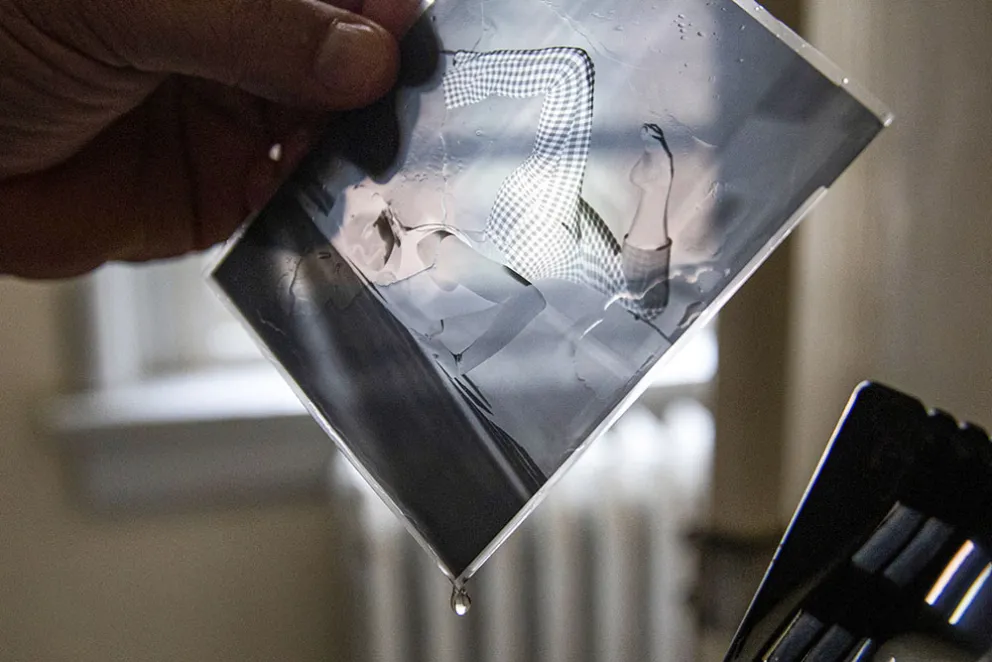
UPAA Blog 2022-23 #5 - 10/27/22 (photo above by Arden Barnes)
If you've paid any attention to the Monthly Image Competition, you've noticed their work. If you attended the 2022 Symposium at the University of Georgia, you saw them work. Who? The Marks: Mark Cornelison of the University of Kentucky, and Mark DiOrio of Colgate University. The guys with the 4x5 cameras.
And if you saw them at work you know that 4x5 film photography is a serious commitment to a craft and process, with upside-down framing, manual everything and several days between tripping the shutter and seeing the result. Sure it's great for a hobby, but is it relevant in our day-to-day of a bazillion frames-per-second and what-you-see-is-what-you-get mirrorless instantaneousness? Both the Marks say yes.
Settle in and read on... -Ed.
************
MARK CORNELISON
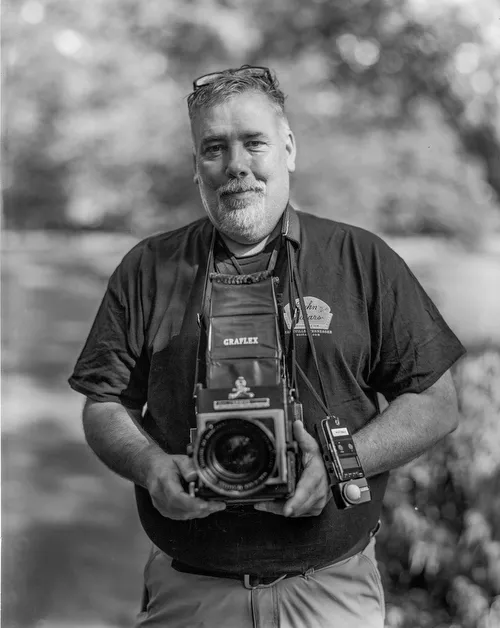
My second year photo class at Eastern Kentucky was all shot on 4x5. Later in my professional career I bought one for my newspaper work (Lexington Herald Leader) and used primarily Polaroid Type 55 and shot a bunch of athletes/coaches with it. They were always a big hit and very unique especially after everything went digital. Those first digital cameras seemed great but in hindsight were really rough. So shooting that film was great because I could show the players a positive on the spot and have a negative to scan later without going through the darkroom process.
I am not 100% sure about the math when it comes to large format lenses. For example a 90mm or 127mm large format lens is considered wide angle so I made a few mistakes buying lenses at first. I mostly used a 150mm early on which was close to a normal lens. Polaroid Type 55 was discontinued so I bought several boxes of it for $100+ each...but didn't store it correctly and it all dried up on me over time. What a waste of money and cool film.
Over the years I would be influenced by a lot of people and their photos in large format. I would look around for some cool lenses and it was hit and miss. Finally I saw Dave Burnett’s Olympic photos from 2012 and LOVED it. I loved the imperfections, the scratches, chemistry marks, and film grain. Man the film grain really got me.
(photo by Mark DiOrio)
When I scanned my first negative I was like “what the hell is this” and it was my old friend film grain back in my life. As I write that last sentence I realize digital photography was/is not really my love. When I was in newspapers with tight deadlines it was amazing but at this point in my career I don’t need that perfection. As for film, I have tried several and at first told myself I was gonna be a Tri-X guy again, really for no reason. Over time I tried several and now love the Ilford HP5 (400). It was a little cheaper than Kodak and looked great.
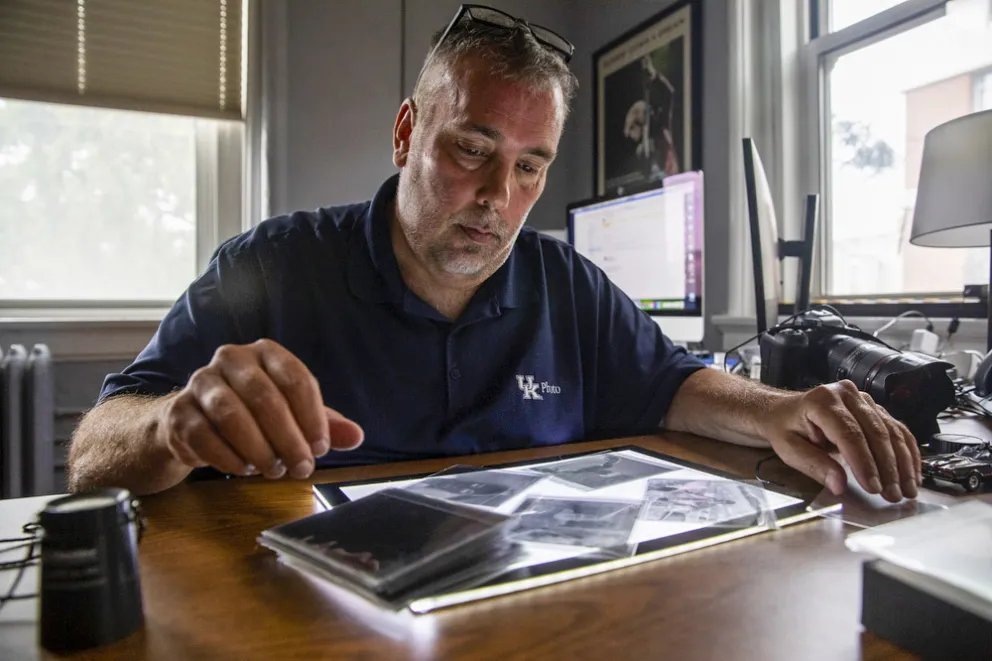
(photo by Arden Barnes) Mark Cornelison looks at negatives on a light box.
I still screw up quite often, many times on composition. If I am shooting outside where it’s bright, or even inside sometimes I don’t put that extra look on my edges and corners and the end result is not always what I wanted in a perfect world.
I'm fortunate to have access to the UK Art department darkroom and chemistry so going over there and processing is a great break from routine. Each tank holds 12 pieces of film and when I shoot too much I usually develop two tanks at once and that’s a pain but necessary. I don’t have the patience to process 12, then do the whole process again. I wanna SEE stuff! Ha!. Loading the tanks was problematic at first till I figured it out and I had some film touches etc. Always painful to have a film touch even on 35mm. After processing I dry the negatives and shoot them on a light table with a 5DmarkIV.
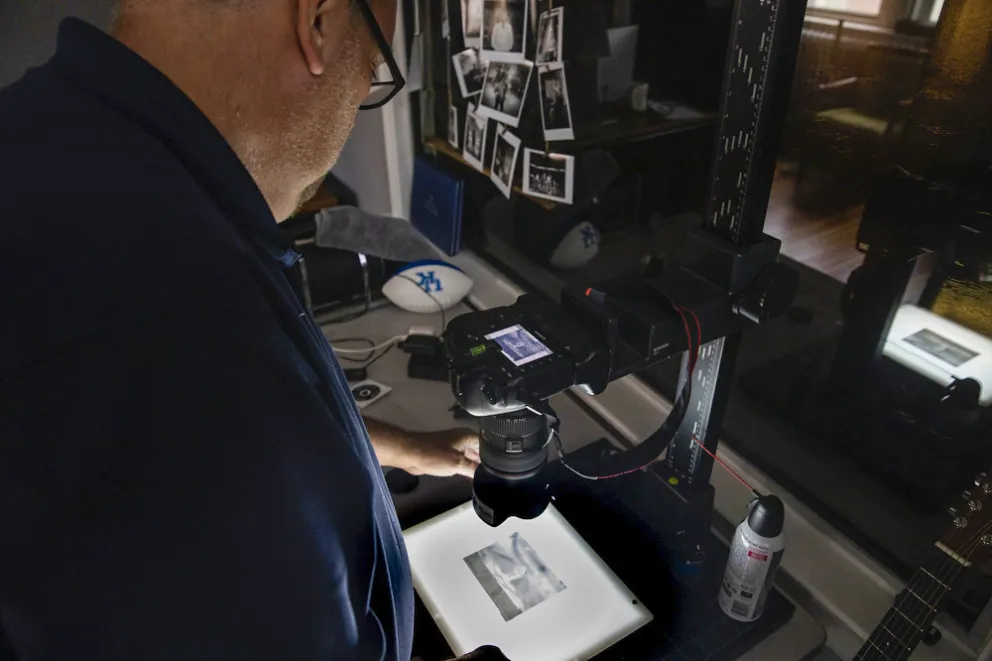
(photo by Arden Barnes) The analog-to-digital conversion with a Canon 5DIV.
For my university work I generally use the camera for portraits. I used to joke with people that someone had to “earn” the Speed Graphic treatment. I remember going to shoot a coach once and I walked in and someone said, “are you using the old camera?" And I said, "No, he hasn’t earned it yet!” Probably sounded like a d$@* but everybody laughed and the coach didn’t hear me.
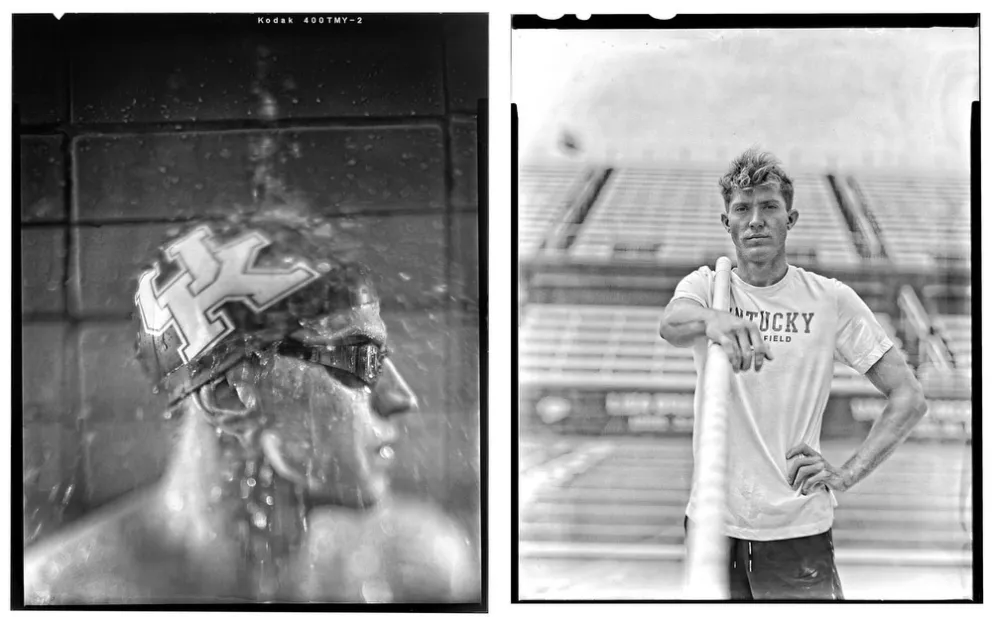
(photos by Mark Cornelison) UK athletes photographed with the ironically-named Speed Graphic.
A new designer saw one and told me “I can “kind of” make one look like that in PhotoShop and I said why do that when we have the real thing. If you think about it, a lot of apps are based on actual older photography methods. Athletics has embraced these and uses them on social media a bunch. Its interesting though because I still feel like the real appreciation comes from holding and looking at a print. I generally give everyone I shoot one signed 8x10. Not sure if that is vain or not, but I think they helped make the photo work and I want them to see it in a print.

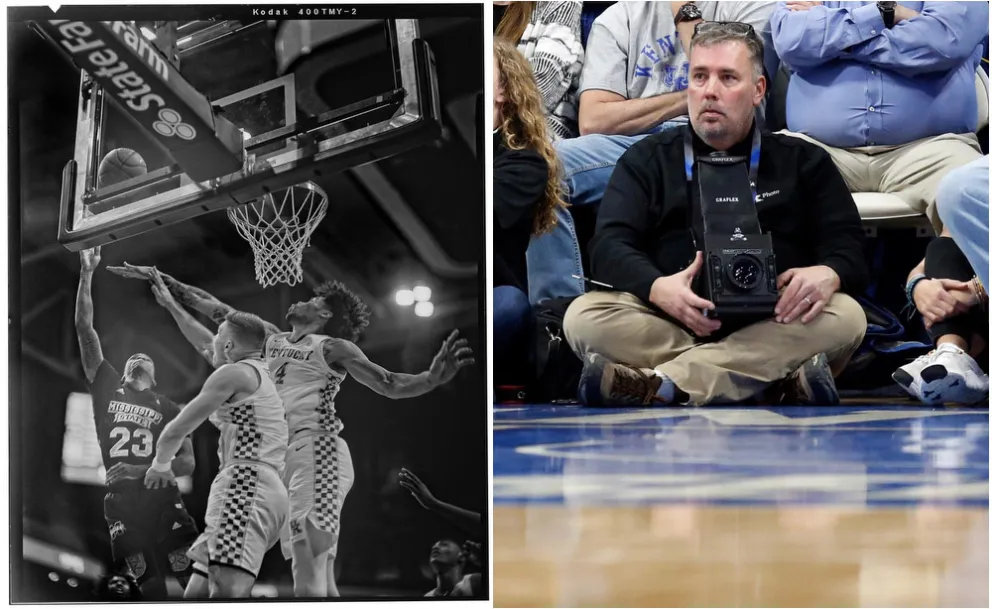
Mark occasionally uses the 4x5 at events--obviously not for short deadline work--and even has a "SLR" 4x5.
I have done a few events but the process is so slow it’s not great for that. I have a SLR 4x5 that I have used on a few events and have a new one being made right now so once I have that, I may stretch out a bit with it. Being able to have it as an SLR really frees you up. I have always loved printing things full frame. We used to file the edges of the negative carrier at the paper when shooting 35mm, or 2 ¼, and I do the same with 4x5. I’m sure it is just dumb pride but I like to show people what I meant the shot to be , not save it later with a crop. No offense to the croppers. I do it on my “regular” school work! Some of my 4x5’s don’t get posted anywhere because I missed it somehow. The focus plane on the Aero Ektar lens is razor thin and sometimes I miss the shot. Either the subject moved a little, or I did, and sometimes I am stubborn and want to shoot at f2.5 when I shouldn’t. I don’t get all the bellows factor talk. I just know it cuts your DOF, and also your exposure. I was told if you have the bellows extended a lot your DOF becomes more like an F0.9 or something crazy. Either way I love the look and am fine with some of the mistakes.
I don’t shoot in color. Not yet anyway. Being able to process myself has been too convenient and I didn’t wanna mess with the critical temperatures of color processing. Maybe later.
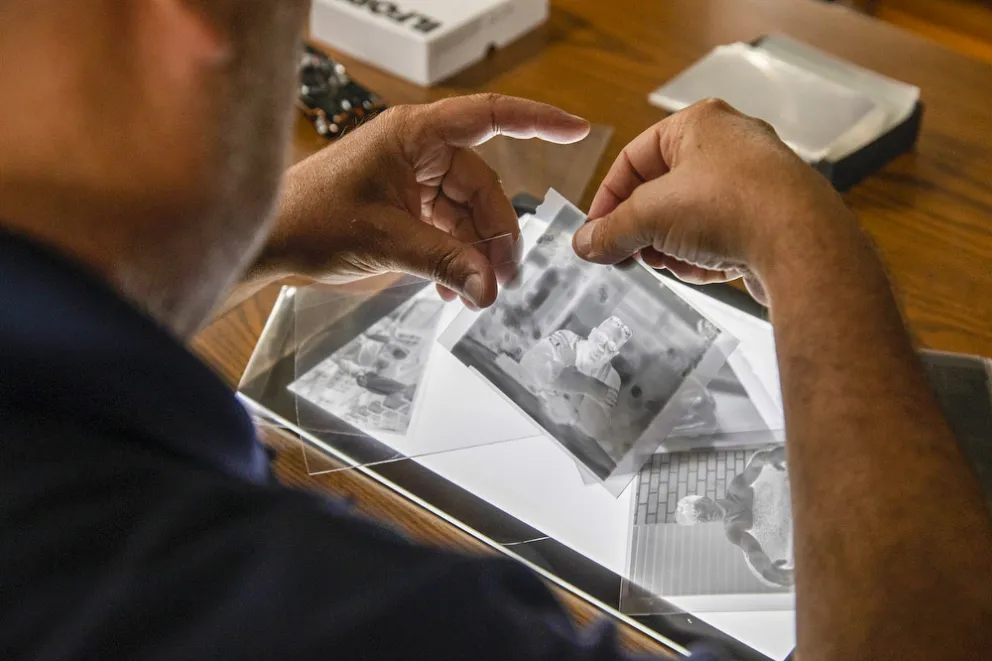
(photo by Arden Barnes) Mark sleeves a photo he made of 2022 UPAA speaker Eli Reed.
I have turned these around same day when I needed to. It’s not optimal and of course I can’t transfer one to a camera quickly for social media!! People who love it love it and those who don’t get it are not my concern really. I love the reaction when someone does get it.

(photo by Arden Barnes) The prince of prints.
One quick little story and I hate that it’s a name drop BUT….. I got hired once to shoot John Mellencamp for American Songwriter magazine. I was told they needed a cover then to shoot his show, so I took the 4x5 camera with me and some Polaroid film. I had it set up next to me on a tripod while I had the 1DX with me for the main spread. There was no guarantee he would sit for me but I was ready to go. Five minutes before he went on he walked in and said “where do you want me” and we did the shoot in less than 5 minutes. I banged off two Polaroids then pulled up the digital camera and rattled off about 20 photos and told him I was done. He looked at the Polaroids and said he liked them, then left to do the show.
A week later I got a call from his manager to meet them In Louisville to shoot his next show because they liked what I did. Because of those two shoots, I was lucky to get many calls from them through the years. Mellencamp later told me he was not planning on doing the portrait that night, but when he walked by the room and saw the 4x5 camera he knew I was a “real” photographer and not just someone with a digital camera. (His Ex wife had been a hobbyist photographer and used a 4x5 before so he knew what it was.) I Love telling that story…
See a video of Mark Cornelison at work with his 4x5 here.
MARK DIORIO

(photo by Mark Cornelison)
My introduction into 4x5 photography came when I took a view camera class while majoring in fine art photography. What I always enjoyed about view camera photography is the level of control over the image making process--such as converging lines and planes of focus (Scheimpflug principle). Additionally, you are starting out with a much larger negative and retain a ton of detail and resolution as a result.
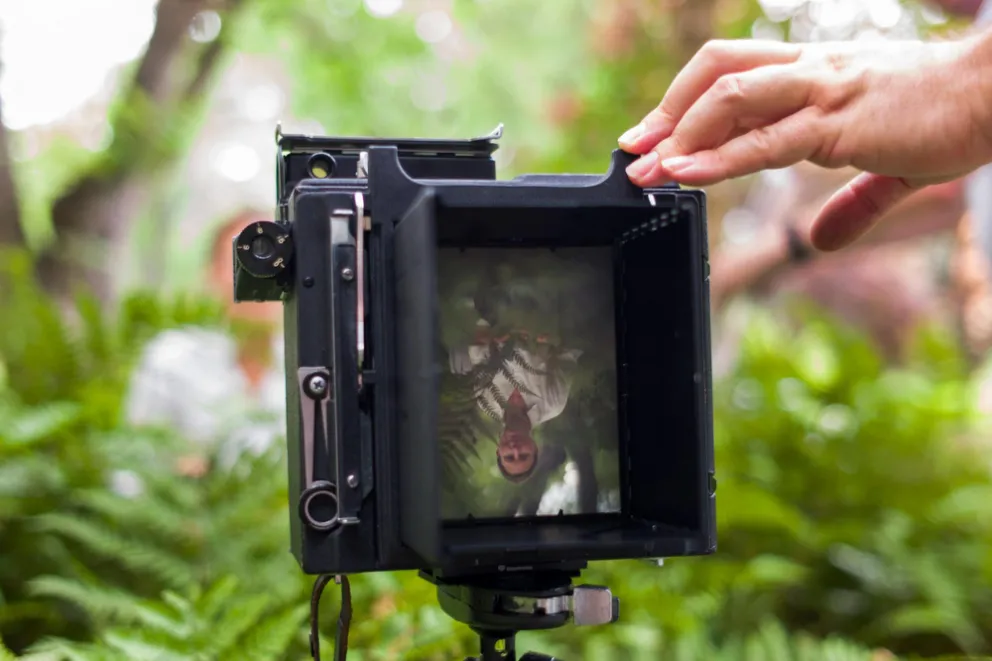
(photo by Tyler Jones) Kristen Grace sits for a portrait at the 2022 Symposium.
It had been over 10 years since I had touched 4x5 photography after making the digital plunge and only started picking it back in recent years. My renewed interest is multi-faceted, and was a result of acquiring an old field camera and also seeing some of the sports photography taken with a Speed Graphic/Aero Ektar lens combination by photojournalist David Burnett, who is known to use old film cameras side-by-side with modern digital equipment, along with many of the portraits made by Mark Cornelison, a fellow UPAA member who also used a similar Speed Graphic setup.
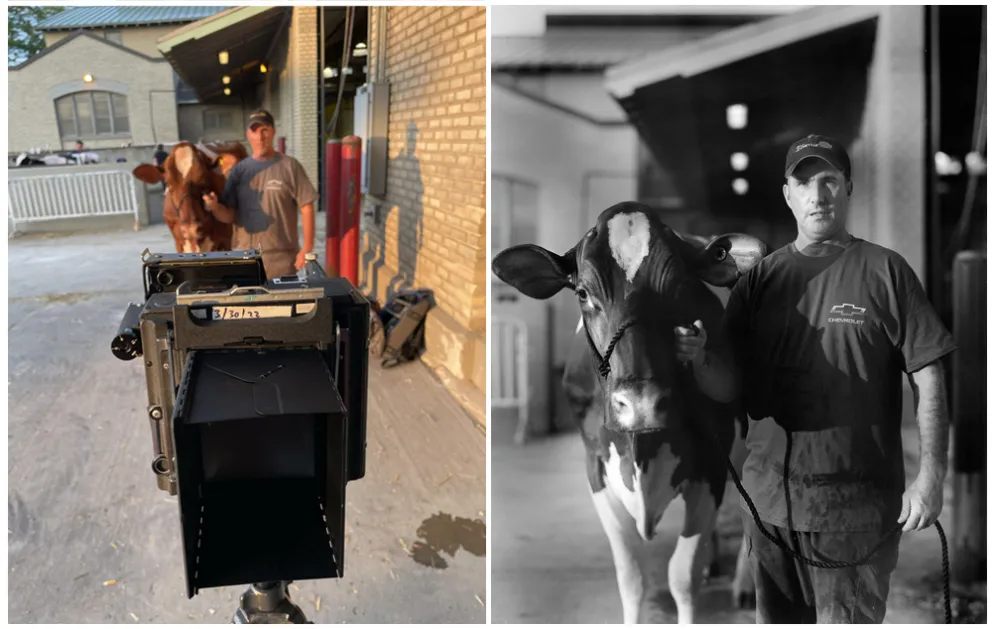
(photos by Mark DiOrio) An analog date stamp
Getting back into 4x5 has also been a great reminder to slow down and make photographs while having to operate in a purely mindful frame of mind. It is a slower process that involves having to focus on each step of the image making process. I find myself double checking to see if the lens is cocked, checking my exposure meter at least twice in the process, and also looking to make sure I pulled the dark slide out of the film holder before making an exposure. This often contrasts with the modus operandi of running and gunning I’m more accustomed to while working on daily assignments for Colgate University.
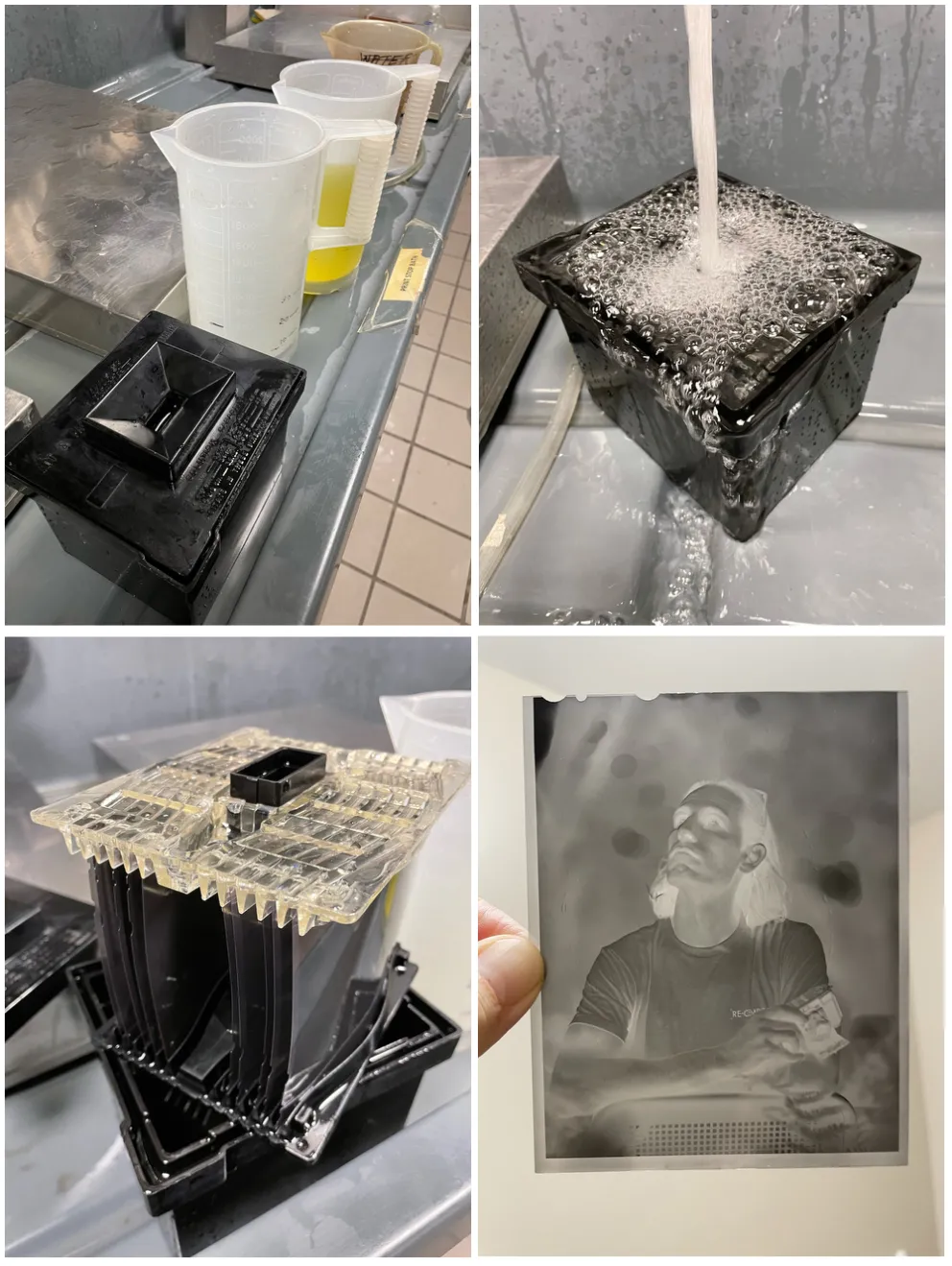
(photos by Mark DiOrio) The analog version of Lightroom!
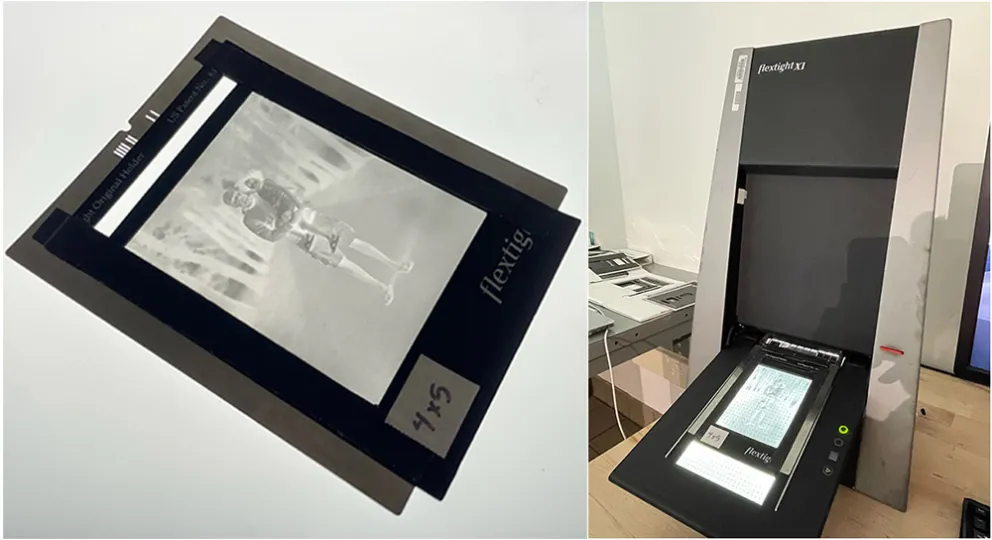
The Flextight X1
How do I digitize these negatives? I use a Flextight X1 drum scanner (coincidentally one of the exact ones I used in grad school 17 years ago) that was donated to Light Work, a photography center at Syracuse University. I typically scan them at the highest possible resolution with the idea that you can always scale down more easily than scale up. Both the machine and the driver software are old, and in the future I would like to adopt Mark Cornelison's method enabling me to do this at. home.
I find that working mindfully in this sense when making 4x5 portraits also finds its way into the digital portraiture I do for Colgate. It helps me to slow down and pay attention to all the steps involved with composition and lighting. It also helps me to be more deliberate in my decision making process, which also crosses over into the digital work I do in my role at Colgate.
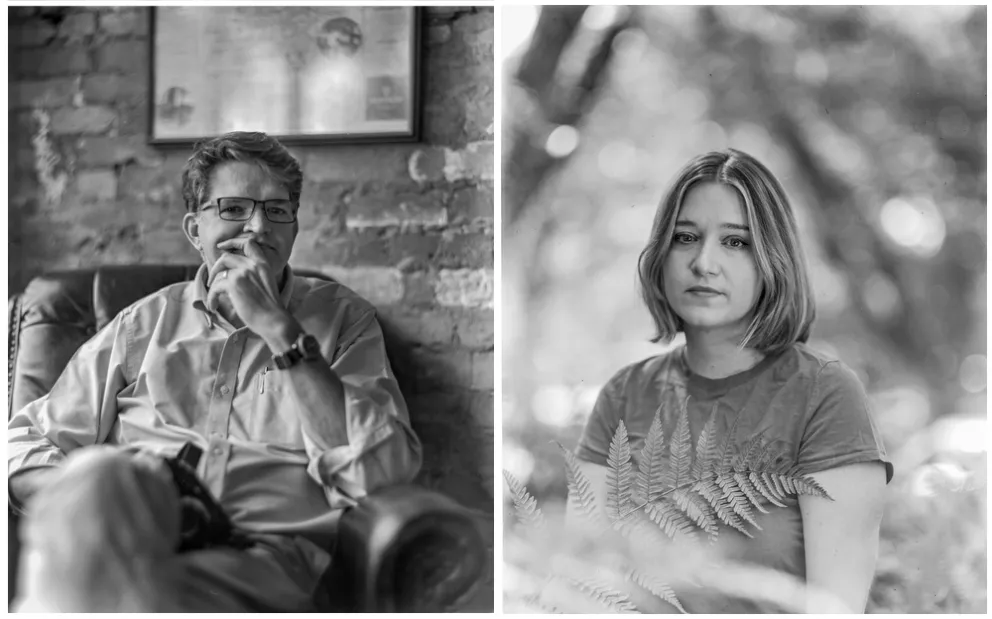
The 4x5 portraits I am currently making are with one of these Graflex/Aero Ektar combinations and as a result, you lack much of the control you would normally have with a standard 4x5 view camera. It is more of an experimental style of large format photography, utilizing a lens originally intended with a fixed infinity focus. As a result, the user must extend the bellows out a bit farther to obtain closer focus on the subject. The lens is known for creating a super-shallow depth of field with sometimes unpredictable swirl patterns in the out-of-focus regions, similar to what early Petzval portrait lenses would deliver. I use an old Speed Graphic 4x5 camera body for the use of the focal plane shutter with this particular lens as the lens lacks a leaf shutter.
4x5 portraiture for me is a recent renaissance, a re-discovery of the film negative and a place where I left off earlier in my career when I traded film for the immediacy of digital and the paycheck that followed. I have embraced the incredibly sharp results and narrow focus along with the unexpected flaws, light flares or fogging in the negative produced by this Frankenstein of old parts that I drag along with me on shoots. I will also admit part of the reason I have jumped back into making portraits with this setup is that people, especially strangers, seem to be more open to having their portrait taken with a vintage 4x5 than they are with the latest and greatest digital camera. I've found that I can connect better when my subject is fascinated by the device I am using and the methods for creating an exposure. Some may think that this is a shortcut or a type of gimmick to break the ice with a person's trust. In defense to that argument, one of Murphy's Laws of Combat Operations comes to mind: If it's stupid and it works, it ain't stupid.
************
"How do you make a small fortune in photography? Start with a large fortune..." Thanks for reading the blog. Articles & suggestions are always welcome. Email editor Matt Cashore, mcashore@nd.edu. And, as always, if you haven't already, follow UPAA on Instagram!